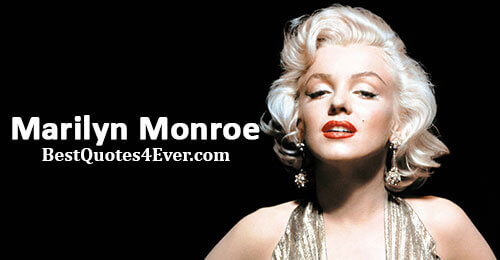Biography
Type: Actress, Singer, Photo model
Born: 1 June 1926
Died: 5 August 1962
Marilyn Monroe, one of the most famous actress, singer and sex symbol of the 50's of the last century, born Norma Jeane Mortenson; June 1, 1926 - August 5, 1962 in Los Angeles, Calif. Her’s brief but very glorious career began with small roles in several films: Ladies of the Chours, The Asphalt Jungle, All About Eve...She was a top-billed actress for only a decade, her films grossed $200 million by the time of her unexpected death in 1962 but she continues to be considered a major popular culture icon.
Filmography:
- Dangerous Years
- Scudda Hoo! Scudda Hay!
- Green Grass of Wyoming
- Ladies of the Chours
- The Asphalt Jungle
- A Ticket to Tomahawk
- All About Eve
- Let’s Make It Legal
- Monkey Business
- We’re Not Married
- Niagara
- How to Marry a Millionare
- Some Like It Hot
- Not so nice childhood
Her’s mother Gladys, a widow and a mental patient abandoned Marilyn to sequence of foster homes. She never knew her father. Marilyn was almost smothered to death at two, nearly raped at six. Growing up, Monroe spent much of her time in foster care and in an orphanage. In 1937, a family friend and her husband, Grace and Doc Goddard, took care of Monroe for a few years. The Goddards were paid $ 25 weekly by Monroe’s mother to raise her. The couple was deeply religious and followed fundamentalist doctrines; among other prohibited activities, Monroe was not allowed to go to the movies. But when Doc’ s job was transferred in 1942 to the East Coast, the couple could not afford to bring Monroe with them. So she come back in an orphanage.
Journey to the stars
At the age of 16 she wed her boyfriend Jimmy Dougherty on June 19, 1942. A merchant marine, Dougherty was later sent to the South Pacific. Monroe went to work in a munitions factory in Burbank, California, where she met photographer David Conover, who had been sent by the U.S. Army Air Forces' First Motion Picture Unit (FMPU) to the factory to shoot morale-boosting pictures of female workers. Although none of her pictures were used by the FMPU, she quit working at the factory in January 1945 and began modeling for Conover and his friends. He also encouraged her to apply to the Blue Book Model Agency,to which she was signed in August 1945. She began to occasionally use the name Jean Norman when working, and had her curly brunette hair straightened and dyed blond. As her figure was deemed more suitable for pin-up than fashion modeling, she was employed mostly for advertisements and men's magazines By the time Dougherty returned in 1946, Monroe had a successful career as a model, and had changed her name to Marilyn Monroe in preparation for an acting career. She dream of becoming an actress.
Impressed by her success, Snively arranged a contract for Monroe with an acting agency in June 1946. Through them, she met Ben Lyon, a 20th Century-Fox executive, who arranged a screen test for her. The studio's head executive Darryl F. Zanuck was unenthusiastic about her. He was persuaded to give her a standard six-month contract in order to avoid her being signed by rival studio RKO Pictures, whose owner Howard Hughes had expressed interest in her after seeing her on a magazine cover.Monroe began her contract in August 1946, and together with Lyon selected her the screen name of "Marilyn Monroe". The first name was picked by Lyon, who was reminded of Broadway star Marilyn Miller; the last was picked by Monroe after her mother's maiden name. In September 1946, she was granted divorce from Dougherty, allowing her to concentrate fully on her acting career.
In the beginning of her acting career, she rarely received roles, for that reason, she was dedicated to the classes of singing, acting and dancing. Later, in those years,she was getting supporting roles in low-budget films, often changing Producers house.Monroe appeared in six films released in 1950. Four of them -Love Happy, A Ticket to Tomahawk, Right Cross and The Fireball- were unremarkable films in which she had only bit parts, but she also made minor appearances in two critically acclaimed films: John Huston‘ s crime film “The Asphalt Jungle” and Joseph Mankiewicz’s drama “All About Eve”. In the former, Monroe played Angela, the young mistress of an aging criminal. Although her on-screen time was only five minutes, she gained a mention in Photoplay and according to Spoto, effectively moved from movie model to serious actress;. In the latter, Monroe played Miss Caswell, a naive young actress.
Nude mood
During the development of her acting career was followed by numerous and unsuccessful affair with various people from the film world. All those people with whom she was having an affair helped her to progress in their careers. The nude photo scandal ensured that all five films in which Monroe appeared in 1952 became popular with the public. The first of these was the drama “Clash by Night”, directed by Fritz Lang and released in June. Monroe was loaned to RKO for the film, in which she was featured in an atypical role as a fish cannery worker, allowing her to show more of her acting range.The performance gained positive reviews; the Hollywood Reporter stated that "she deserves starring status with her excellent interpretation," and the Daily Variety wrote that she "has an ease of delivery which makes her a cinch for popularity."In July, Monroe starred in two films, as a beauty pageant contestant in the comedy “We're Not Married!” and as a mentally disturbed babysitter in the thriller “Don't Bother to Knock”. According to its writer, Nunnally Johnson, the former role was created solely to "present Marilyn in two bathing suits", but the latter film was intended as a vehicle for her to show that she could act in heavier dramatic roles. It received mixed reviews from critics, with Bosley Crowther deeming her too inexperienced for the difficult role, and Variety blaming the script for the film's problems. Her next role as an attractive secretary opposite Cary Grant in Howard Hawks' screwball comedy “Monkey Business” was one of the first to feature her as a "dumb, childish blonde, innocently unaware of the havoc her sexiness causes around her", marking the beginning of typecasting in her career. Monroe's final film of the year was “ Henry's Full House”, in which she appeared in a minor role as a prostitute. Movies “Niagara” (1953) and “Gentlemen Prefer Blondes” (1953) launched her as a sex symbol superstar.
Personal wife/life
Hers an exciting personal life is full of ups and downs, relationship, marriage, and divorces. Monroe had three marriages, all of which ended in divorce. The first was to James Dougherty, the second to Joe DiMaggio, and lastly to Arthur Miller. It is claimed she was briefly married to writer Robert "Bob" Slatzer. She is alleged to have had affairs with both John and Robert Kennedy. Marlon Brando, in his autobiography Songs My Mother Taught Me, claimed that he had had a relationship with her, and that they remained friends until her death. She also suffered two miscarriages and an ectopic pregnancy during her three marriages.
The End
Marilyn Monroe was found dead on August 5, 1962 in the bedroom of her Brentwood home by her psychiatrist Dr. Ralph Greenson. She was 36 years old. Her death was determined to have been caused by barbiturate overdose, and was ruled a probable suicide.
Although neither the investigation in 1962 or its review in 1982 could find any evidence that she had been the victim of a crime, Monroe's death has been the subject of several conspiracy theories. Many of these involve President John F. Kennedy and his brother Robert F. Kennedy, as well as union leader Jimmy Hoffa and mob boss Sam Giancana. Besides theories that she was murdered, there have been allegations that her death was an accidental overdose.
Marilyn made only 30 films in her lifetime, but her legendary status and mysticism will remain with film history forever.








